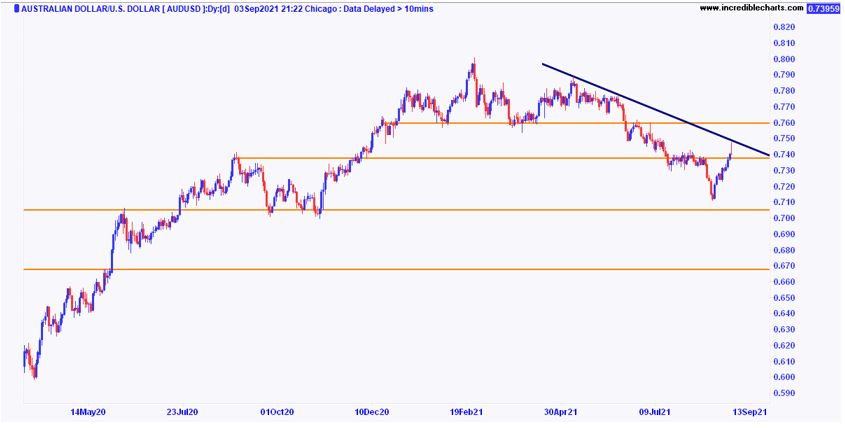In today’s Money Morning…the more important question…the last fair market?…back to ‘risk-on’…and more…
The subject of trust came up in a recent editor’s call here at work.
The general feeling was that trust in authority figures has never been lower.
People don’t trust their governments, they don’t trust big media, they don’t trust academics, and they especially don’t trust our economic masters.
In this void of distrust, uncertainty, fear, and anger take hold.
You’re probably seeing it play out in everyday life at some level.
You can certainly see it in the writings of many financial commentators.
A lot of them are calling for an imminent market crash, or at least a big correction, very soon.
And they’ll be right…one day.
But are they right, right now?
That’s the more important question.
With that in mind, I’m watching one chart very closely.
And contrary to the doomsayers doomsaying, it’s actually close to saying we’re due for another leg higher soon.
Let me explain more…
The last fair market?
If you’re looking at the pure indices — the Dow Jones, the Nasdaq, the ASX200 — things are in a clear uptrend.
In fact, we’re at near all-time highs on most of the world’s major markets. Usually that makes people more confident in the future.
The problem is a lot of people just aren’t buying it.
As I alluded to at the start, people just don’t trust that stock market valuations are a true reflection of reality right now.
Even less trusted are bond markets.
Central banks have explicitly stated they’re manipulating yields — so-called yield curve control — at an unprecedented level of monetary interference.
If you want to see how crazy this has gotten, consider the fact that there are 12 junk rated corporate bonds in Europe paying investors negative interest rates right now.
Junk rated bonds are rated below investment grade by the big three rating agencies because of the higher risk of default.
And yet today, you’ve got to pay them to lend them money!?!?
I don’t think I need to go into too much detail to convey how nuts this all is.
And many clues the bond market once gave on the true state of the economy are gone in my opinion.
So where can you look for a true signal you can trust in amongst all this fakery?
Funnily enough, it’s a market close to home — the Aussie dollar.
The Aussie dollar is the fourth or fifth most traded currency, a fact that belies the size of our economy.
The reason it’s such a trader’s favourite is that it’s by and large a ‘commodity’ currency.
The strength of our currency is basically a reflection of the strength of the commodity market, which is in turn a good gauge for global growth.
PS: We reveal four little-known small-cap stocks that cannot be ignored…Download your free report now.
Our currency is traded pretty freely. We don’t have the central bank muscle to intervene too much. It might even be the last fair market we have right now.
So what’s it saying today?
Check it out:
|
|
|
Source: Incredible Charts |
You can see our currency has been getting weaker since around May.
In fact, things were looking pretty dicey this month with the currency plummeting fast.
There were multiple reasons for this.
Taper talk in the US, more lockdowns at home, Chinese threats on trade, iron ore prices finally falling back a bit…
But with a good signal, you don’t need to know what the reasons are, you just need to know it’s a decent reflection of reality.
Which is why the strong bounce back since 23 August is interesting.
So what happened just over two weeks ago?
Back to ‘risk-on’
Keen market observers will probably remember 23 August was the start of the annual Jackson Hole Federal Reserve symposium in the United States.
The main message to the markets was that the Fed was probably going to kick the can down the road when it came to ending their loose monetary policy positions.
We’ll see if that initial reaction proves to be correct in the month ahead, but investors are clearly thinking this part has longer to go.
And the rise in the Aussie dollar reflects that.
The next few weeks will be interesting.
If the Aussie can push past the 76-cent level, then the flow of money back into more speculative positions might have legs.
Indeed, I’ve started to get multiple entry signals in my small-cap trading service, which suggests some early traders are already moving back in.
The question is whether this bounce back has legs.
If it fades away, then it could be time to batten down the hatches again. On the downside, a break back to 72 cents might suggest markets are going lower.
That doesn’t mean there won’t be opportunities though. A lower Aussie dollar can be good for value-driven exporters.
Keep an eye on it…
Good investing,
 |
Ryan Dinse,
Editor, Money Morning
PS: Ryan is also editor of New Money Investor, a monthly advisory aimed at helping investors take an early-mover advantage as decentralised finance and digital money take over the world. For information on how to subscribe and see what Ryan’s telling his subscribers right now, click here.


